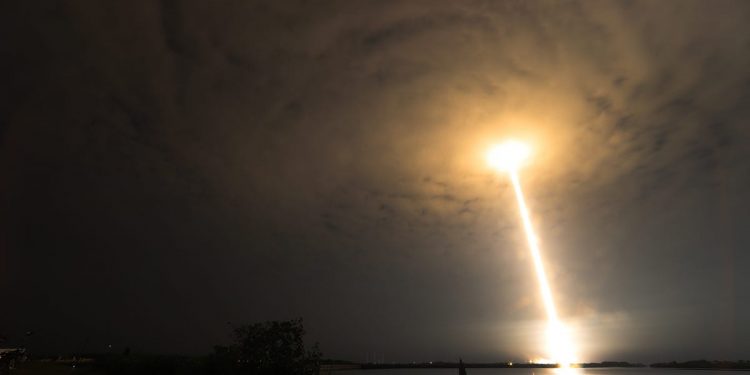Rocket Launches Could Be Polluting Our Atmosphere in New and Unexpected Ways – Gizmodo – TodayHeadline
The bright trail of a rocket launch against the sky
SpaceX, Blue Origin, and a host of other private companies helped to make 2021 the year with the most space launches in history, but scientists say this mad dash to space could be causing further damage to our atmosphere.
The number of launch attempts has doubled in the last decade. And after counting all of the planned launches for 2022, it seems the current year is set to blow past last year’s record. But rocket launches come with big emissions, the atmospheric impact of which isn’t fully understood.
Now, two scientists have added to the growing body of knowledge suggesting that the race to leave the Earth could be harming our planet and our health. The researchers referenced a webcast video to model a SpaceX launch in painstaking detail. Their simulation showed that exhaust from the rocket dumped a surprising amount of climate-altering carbon gases, as well as harmful nitrogen oxides, across multiple levels of the atmosphere.
“Pollution from rockets should not be underestimated as frequent future rocket launches could have a significant cumulative effect on climate,” wrote the researchers in their paper, published Tuesday in the journal Physics of Fluids. They also mentioned the possibility of rocket launches becoming a future human health hazard.
“At present, the risk is low because a small number of launches take place,” Dimitris Drikakis, a physicist and engineer at the University of Nicosia in Cyprus and co-author of the new study, explained in an email to Gizmodo. “The problem may become significant when frequent launches take place.”
Experience Next-Level Sound
Spatial audio with dynamic head tracking provides theater-like sound that surrounds you
Drikakis and his University of Nicosia colleague Ioannis Kokkinakis specifically looked at the exhaust emissions from a computer model they built, one meant to closely match the 2016 Thaicom-8 launch of SpaceX’s Falcon 9 rocket, which obtained its power from the fuel RP-1, or Rocket Propellant-1, which is similar to jet fuel. The researchers considered the role of heat, pressure, gas mixing, dispersal patterns, and other factors to estimate rocket emissions at various heights and up to a maximum 41.6 miles (67 kilometers) above the surface.
Earth’s atmosphere has multiple levels based on altitude, each exhibiting its own unique set of conditions. Drikakis and Kokkinakis followed their modeled rocket launch from the near-Earth troposphere through to the stratosphere and into the mesosphere.
Based on their models, the researchers estimated that the single Falcon 9 rocket produced around 116 metric tons of carbon dioxide in the first 165 seconds of its journey. “This amount is equivalent to that emitted by about 69 cars over an entire year [in the United Kingdom],” wrote Drikakis to Gizmodo. To repeat: 69 car years of driving versus 165 seconds of rocket flight.
Carbon dioxide accumulates in the lower atmosphere as we burn fossil fuels, and is the greenhouse gas largely responsible for human-caused climate change. But much of the emissions produced in the model study appeared in the higher altitude mesosphere, where the climate impacts of C02 are less well understood than they are closer to Earth. For each kilometer climbed by the rocket at the highest altitudes examined, the simulated Falcon 9 sent out a mass of carbon dioxide equal to 26 times the amount already present in one cubic kilometer of the mesosphere.
At the same time, the rocket also shot out similar amounts of carbon monoxide and water vapor, which are typically only present in the mesosphere in trace amounts. This now adds to the list of poorly understood atmospheric changes that rocket launches could be creating.
And then there are the dreaded nitrogen oxides (NOx) to consider. On top of being bad-to-breathe pollutants that can trigger respiratory diseases, these gases also degrade our atmosphere’s critical ozone layer. In the first 70 seconds of the studied launch, the SpaceX rocket produced an estimated one metric ton of NOx, equivalent to about 1,400-cars-worth of annual emissions, according to Drikakis. Nitrogen oxides form best under high heat, so most of that release happened in the lower atmosphere, specifically at altitudes below 6.2 miles (10 km).
“CO2 and other greenhouse gas species [types] emitted in the mesosphere can affect the climate, if emitted in enough quantity,” said Erik Larson, a geoscientist at Harvard University who was not involved in the new research, in an email to Gizmodo. But he added that this paper doesn’t actually assess the climate impacts of the rocket launch.
Instead, Larson said the study’s value is in its estimates of emission quantities. The study “fills some gaps,” he explained. In particular, Larson thought the most “important contribution” from the new research had to do with nitrogen oxide production and the potential for ozone risk, as opposed to assessments of direct air-quality impacts. “It destroys the beneficial ozone layer,” he said. “I think the important global impacts of rocket NOx emissions are likely to be destruction of stratospheric ozone as opposed to air quality.”
The ozone layer protects our planet’s surface from the most damaging of the Sun’s rays. Without it, much of life on Earth would die. And we nearly lost it once before owing to chemical emissions. After the offending, damaging compounds were banned, the ozone layer recovered, but it has remained a constant concern ever since.
A 2018 UN report concluded that rocket launches have a teeny tiny (sub 0.1%) impact on the ozone. But ozone loss due to rocket launches could be more than 10 times higher than previously assumed due to the a lack of research on the topic, according to the new study. And, again, there are many more rockets going into space now than there were even four years ago.
It’s important to restate that the new study is dependent on estimates and models, which means it has major limitations. “The atmosphere is a very complex system,” said Drikakis. He pointed out that his team had to reckon with a lot of uncertainty when obtaining these results owing to the lack of clear information about the physical and chemical processes happening across higher altitudes of the atmosphere.
In addition to chipping away at those uncertainties, the scientists plan to further explore the link between ozone depletion and space launches in future research. They also hope that more studies examine the impact of mesosphere changes on Earth’s climate.
But for now, even knowing all of the above, Drikakis and Kokkinakis are still pro-space exploration. “We are rocket enthusiasts and believe that the commercial sector has made amazing progress in the field,” Drikakis told me. “We are at the beginning of a fantastic journey” that we should continue, he added.
He hopes their research and studies like it will help the burgeoning space industry “design solutions that will improve the rockets’ design and mitigate the effects of exhaust gases.” For Earth’s sake, lets all hope that innovation comes at rocket-speeds.
Source: Rocket Launches Could Be Polluting Our Atmosphere in New and Unexpected Ways – Gizmodo

